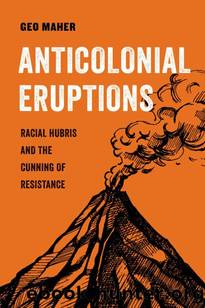Anticolonial Eruptions (American Studies Now: Critical Histories of the Present) by Geo Maher

Author:Geo Maher [Maher, Geo]
Language: eng
Format: epub
ISBN: 9780520379350
Publisher: University of California Press
Published: 2022-03-28T18:30:00+00:00
Moles
In 1966, occupying US military forces built a base in the Củ Chi District of what was then called Saigon, in what was then called South Vietnam. The Củ Chi base came under immediate attack, but it wasnât at all clear from where. âBlack-clad guerrillas soon began organizing attacks on the base, popping out at night to blow up planes and steal weapons and equipment, including a tank, before disappearing into the darkness. The US military responded by declaring the area around Củ Chi a âfree fireâ zone and pounded it with artillery, bombs, and even napalm in hopes of destroying the Vietcong. Yet the raids continued: from their tunnels, the Vietnamese guerrillas could wait out US bombing raids and then prepare to strike again.â
The tunnels, one National Liberation Front (NLF) officer later recalled, âwere like a thorn stabbing the enemy in the eyeâ that the US military was unable to extricate. Between the literal and figurative undergrounds, the relationship was direct: thanks to the tunnels, communist forces were able to infiltrate the US base so thoroughly that, at one point, âall thirteen of the baseâs barbers were members of the Vietcong.â1 In the words of one brigadier general, US troops âdidnât realize that they had bivouacâd on a volcano.â2
Tunnel warfare is as old as walls themselves, with specially trained sappers quite literally under-mining otherwise impenetrable fortifications, leading to their collapse, orâwith the invention of gunpowderâtheir demolition from below. But tunnels have just as often been weapons of the weak. The Great Jewish Revolt of 66 CE was launched against the Romans from tunnels and caves, and survivors of the Warsaw Ghetto Uprising later fled through the Muranowski Tunnel to escape certain death at the hands of a later generation of would-be Romans. The undergrounding of the underground became even more urgent during and after the Korean War, as North Korean and Chinese forces dug in to evade US air supremacy, building âunderground fortifications so extensive that for every mile of military front on the surface, there were two miles of underground tunnelsâmore than 300 miles in total.â3
The tunnels at Củ Chi were first developed by the Viet Minh in the 1950s to fight the French occupationâwith more than a bit of help from the Koreans. Legendary Vietnamese general Võ Nguyên Giáp recalled the importance of trenches and tunnels for defeating the superior French forces ensconced at Dien Bien Phu: âThe fortified entrenched camp had quite powerful artillery fire, tank and air forces,â he wrote. âWe overcame this difficulty by digging a whole network of trenches that encircled and strangled the entrenched camp.â.â.â. These wonderful trenches enabled our forces to deploy and move in open country under the rain of enemy napalm bombs and artillery shells.â Giáp noted how these trenches, more than simply providing protection, gradually formed a vast âmobileâ camp of their own, ensnaring the enemy as if in a spiderweb.4
The Vietnamese defeat of the French at Dien Bien Phu shattered myths of Frenchâand more broadly, colonial and
Download
This site does not store any files on its server. We only index and link to content provided by other sites. Please contact the content providers to delete copyright contents if any and email us, we'll remove relevant links or contents immediately.
The Secret History by Donna Tartt(18807)
The Social Justice Warrior Handbook by Lisa De Pasquale(12126)
Thirteen Reasons Why by Jay Asher(8767)
This Is How You Lose Her by Junot Diaz(6761)
Weapons of Math Destruction by Cathy O'Neil(6116)
Zero to One by Peter Thiel(5661)
Beartown by Fredrik Backman(5575)
The Myth of the Strong Leader by Archie Brown(5403)
The Fire Next Time by James Baldwin(5224)
How Democracies Die by Steven Levitsky & Daniel Ziblatt(5111)
Promise Me, Dad by Joe Biden(5077)
Stone's Rules by Roger Stone(5013)
100 Deadly Skills by Clint Emerson(4824)
A Higher Loyalty: Truth, Lies, and Leadership by James Comey(4822)
Rise and Kill First by Ronen Bergman(4682)
Secrecy World by Jake Bernstein(4618)
The David Icke Guide to the Global Conspiracy (and how to end it) by David Icke(4606)
The Farm by Tom Rob Smith(4421)
The Doomsday Machine by Daniel Ellsberg(4397)
